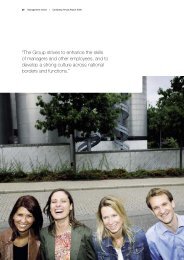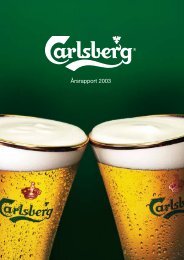Trends in the global beer markets - Carlsberg Group
Trends in the global beer markets - Carlsberg Group
Trends in the global beer markets - Carlsberg Group
- No tags were found...
You also want an ePaper? Increase the reach of your titles
YUMPU automatically turns print PDFs into web optimized ePapers that Google loves.
14 Management review: Markets and strategy<strong>Trends</strong> <strong>in</strong> <strong>the</strong><strong>global</strong> <strong>beer</strong><strong>markets</strong>THE GLOBAL BEER INDUSTRYBrew<strong>in</strong>g has historically been a local<strong>in</strong>dustry with only a few companieshav<strong>in</strong>g a substantial <strong>in</strong>ternationalpresence. However, <strong>the</strong> last coupleof decades have seen <strong>in</strong>creas<strong>in</strong>gconsolidation with<strong>in</strong> <strong>the</strong> <strong>in</strong>dustry, adevelopment which <strong>in</strong>itially took off <strong>in</strong>Western Europe and North America.More recently, <strong>the</strong> consolidation beganto <strong>in</strong>clude brew<strong>in</strong>g companies <strong>in</strong> <strong>the</strong>growth <strong>markets</strong> of Eastern Europe,Asia and Lat<strong>in</strong> America.The <strong>global</strong> consolidation process hasaccelerated <strong>in</strong> <strong>the</strong> past ten years. Thetop 10 brewers accounted for 34%of <strong>the</strong> <strong>global</strong> <strong>beer</strong> market <strong>in</strong> 1998. In2008, this figure had grown to 59%.In 2008, two major acquisitions tookplace <strong>in</strong> <strong>the</strong> <strong>global</strong> brew<strong>in</strong>g <strong>in</strong>dustry:• The acquisition of Scottish & Newcastleby <strong>Carlsberg</strong> and He<strong>in</strong>eken• The acquisition of Anheuser-Buschby InBevFollow<strong>in</strong>g <strong>the</strong> acquisitions this year,<strong>Carlsberg</strong> is <strong>the</strong> fourth largest brewer<strong>in</strong> <strong>the</strong> world with an approximate worldmarket share of 5%.The dynamics of <strong>beer</strong> consumption vary significantly across<strong>the</strong> world. In mature Western European <strong>markets</strong> volumesare broadly stable or decl<strong>in</strong><strong>in</strong>g modestly. In contrast, lessmature or emerg<strong>in</strong>g <strong>beer</strong> <strong>markets</strong> <strong>in</strong> Asia and Eastern Europeare grow<strong>in</strong>g, with some countries even show<strong>in</strong>g quite rapidgrowth rates.Volume drivers and trendsGlobal <strong>beer</strong> volumes are primarily be<strong>in</strong>g driven by grow<strong>in</strong>gdisposable <strong>in</strong>come, improvements <strong>in</strong> <strong>the</strong> quality of <strong>beer</strong>,market<strong>in</strong>g and advertis<strong>in</strong>g activities, and a steadily grow<strong>in</strong>g<strong>beer</strong>-consum<strong>in</strong>g population base.An ongo<strong>in</strong>g trend evident <strong>in</strong> emerg<strong>in</strong>g and growth <strong>markets</strong>is <strong>the</strong> substitution of <strong>beer</strong> <strong>in</strong> place of traditional, local spirits.This trend is driven by ris<strong>in</strong>g <strong>in</strong>comes and <strong>in</strong>creas<strong>in</strong>g responsivenesstowards brands and market<strong>in</strong>g. In addition, demographicshifts towards urbanisation and <strong>in</strong>creas<strong>in</strong>g westernisationof tastes among younger generations have supported<strong>the</strong> shift towards <strong>beer</strong>. In mature <strong>markets</strong>, consumption ratesvary based on product differentiation, and market<strong>in</strong>g andpromotional activities.Beer consumption is also affected by a range of o<strong>the</strong>rfactors, <strong>in</strong>clud<strong>in</strong>g seasonality, wea<strong>the</strong>r, demographics,tax and duties, perceived health effects, responsible-useprogrammes, rules and regulations and <strong>the</strong> consumption ofsubstitute products.ON-TRADE AND OFF-TRADEBeer consumption is described as be<strong>in</strong>gsplit between on-trade and off-tradeconsumption. On-trade refers to <strong>beer</strong>purchased <strong>in</strong> a bar or restaurant.Off-trade refers to <strong>beer</strong> purchased ata retail outlet. The relative importanceof <strong>the</strong> on-trade or off-trade segmentsvaries from country to country.Consumption patternsThere are clear differences across <strong>markets</strong> <strong>in</strong> <strong>the</strong> types of<strong>beer</strong> consumed depend<strong>in</strong>g upon, among o<strong>the</strong>r th<strong>in</strong>gs, <strong>the</strong>historical brew<strong>in</strong>g traditions with<strong>in</strong> a given country and <strong>the</strong>market’s maturity level. In most <strong>markets</strong>, <strong>the</strong>re are one ormore ma<strong>in</strong>stream lager brands as well as discount brands at<strong>the</strong> lower end of <strong>the</strong> market. At <strong>the</strong> higher end of <strong>the</strong> market,<strong>the</strong>re are premium brands, super-premium brands andimported brands.Because <strong>beer</strong> is often consumed <strong>in</strong> a social sett<strong>in</strong>g, brandimage is very important. Market<strong>in</strong>g plays a major role <strong>in</strong>creat<strong>in</strong>g and re<strong>in</strong>forc<strong>in</strong>g a brand’s image and typicallybecomes <strong>in</strong>creas<strong>in</strong>gly important <strong>in</strong> highly differentiated<strong>markets</strong>. Domestic and regional brands can establish astrong base while <strong>the</strong> premium brand category becomespopular as consumers look for a better image or new tastes.
<strong>Carlsberg</strong> Annual Report 2008 15NORTHERN & WESTERN EUROPE EASTERN EUROPE ASIANor<strong>the</strong>rn & Western Europe comprisesmature <strong>markets</strong> as well as less mature<strong>markets</strong> <strong>in</strong> <strong>the</strong> eastern part of <strong>the</strong> region.Eastern Europe covers <strong>the</strong> growth <strong>markets</strong>of Russia and <strong>the</strong> Ukra<strong>in</strong>e and a number ofemerg<strong>in</strong>g <strong>beer</strong> <strong>markets</strong>.Asia comprises old, mature <strong>Carlsberg</strong><strong>markets</strong> and new emerg<strong>in</strong>g <strong>beer</strong> <strong>markets</strong><strong>in</strong> Ch<strong>in</strong>a, Vietnam and India, amongst o<strong>the</strong>rs.<strong>Carlsberg</strong> is <strong>the</strong> second largest brewer<strong>in</strong> <strong>the</strong> region with market leader positions<strong>in</strong> a large number of countriesand significant market positions <strong>in</strong>o<strong>the</strong>r countries.The region comprises mature <strong>markets</strong>like <strong>the</strong> Nordic countries, <strong>the</strong> UnitedK<strong>in</strong>gdom, France, Germany, Switzerlandand Italy, where growth rates areexpected to be flat or slightly decl<strong>in</strong><strong>in</strong>g.The region also comprises <strong>markets</strong> likePoland, <strong>the</strong> Baltic States and countrieson <strong>the</strong> Balkan Pen<strong>in</strong>sula, where longterm<strong>beer</strong> consumption is still expectedto grow.Volumes are generally supported bya well-established retail structure, astrong tradition of <strong>beer</strong> consumption <strong>in</strong>most of <strong>the</strong> region and consumers whoare receptive to <strong>in</strong>novation.The competitive landscape varies fromcountry to country. For example, <strong>in</strong><strong>the</strong> Nordic region <strong>Carlsberg</strong> competesma<strong>in</strong>ly with local players andlocal <strong>beer</strong> brands, while <strong>in</strong> <strong>the</strong> UnitedK<strong>in</strong>gdom and France <strong>Carlsberg</strong> is upaga<strong>in</strong>st large <strong>in</strong>ternational brewers and<strong>in</strong>ternational brands.The Eastern Europe region covers<strong>the</strong> growth <strong>markets</strong> of Russia and<strong>the</strong> Ukra<strong>in</strong>e and <strong>the</strong> emerg<strong>in</strong>g <strong>beer</strong><strong>markets</strong> of Kazakhstan, Uzbekistan,Belarus and Azerbaijan.<strong>Carlsberg</strong>’s Russian brewery, Baltika,is a strong market leader <strong>in</strong> Russia,and <strong>in</strong> <strong>the</strong> Ukra<strong>in</strong>e <strong>Carlsberg</strong> holds ano. 3 position. In both countries, <strong>the</strong>competition primarily comes from<strong>in</strong>ternational brewers.The <strong>beer</strong> <strong>markets</strong> <strong>in</strong> this region arestill expected to show positive growthrates as an average trend <strong>in</strong> <strong>the</strong> com<strong>in</strong>gyears.The region is characterised by along tradition of alcohol consumption,strong domestic brands, rapidlymodernis<strong>in</strong>g distribution systems and<strong>in</strong>creas<strong>in</strong>g disposable <strong>in</strong>come. Theemergence of an aspirational middleclass look<strong>in</strong>g to differentiate itself fromprior generations that consumed lowquality,high-alcohol-content spiritshas also had a positive effect on <strong>beer</strong>consumption, not least <strong>in</strong> <strong>the</strong> premiumand licensed segments.<strong>Carlsberg</strong>’s activities <strong>in</strong> Asia comprise<strong>the</strong> mature <strong>markets</strong> <strong>in</strong> Malaysia, HongKong and S<strong>in</strong>gapore, and emerg<strong>in</strong>g<strong>markets</strong> <strong>in</strong> Ch<strong>in</strong>a, Vietnam, Cambodia,Laos and South Asia, <strong>in</strong>clud<strong>in</strong>g India.The Asian <strong>beer</strong> <strong>markets</strong> are characterisedby large populations, grow<strong>in</strong>geconomies, ris<strong>in</strong>g per capita <strong>in</strong>comesand improv<strong>in</strong>g <strong>in</strong>frastructure.In <strong>the</strong> region’s emerg<strong>in</strong>g <strong>markets</strong> <strong>beer</strong>consumption per capita is generallylow but with high projected growthrates <strong>in</strong> <strong>the</strong> com<strong>in</strong>g years.The presence of <strong>in</strong>ternational brewers<strong>in</strong> <strong>the</strong> region is high. In many cases, <strong>the</strong>exposure of <strong>the</strong> <strong>in</strong>ternational brewersto <strong>the</strong> region is through jo<strong>in</strong>t venturearrangements or <strong>in</strong>vestments <strong>in</strong> localbrewers.See also: www.carlsberggroup.com/company/<strong>markets</strong>
16 Management review: Markets and strategyMarketoverviewOur <strong>markets</strong> Our breweriesPopulation(million)GDP/capita(USD) 1GDPgrowth Market(%) 2 maturityMarketgrowth2008-13 Breweries EmployeesNor<strong>the</strong>rn &Western EuropeDenmark 5.5 37,200 0.2 U 1 2,246Norway 4.6 56,850 1.8 j 3 1,547Sweden 9.0 37,620 0.6 U 1 996F<strong>in</strong>land 5.2 37,190 1.6 j 2 1,003Baltic States 4 7.4 19,1807-2.3-4.4 j 4 1,454United K<strong>in</strong>gdom 60.9 36,310 0.7 U 2 1,985Germany 82.4 35,150 1.4 UNor<strong>the</strong>rn Germany 5 4 1,398Switzerland 7.6 42,250 2.0 U 2 1,425France 62.2 35,130 0.9 U 1 2,238Italy 58.2 31,370 -0.4 j 1 687Greece 10.7 31,220 2.6 j 1 287Portugal 10.7 22,550 0.4 j 1 775Poland 38.5 17,770 5.1 W 3 1,325South East Europe 6 22.0814,18182.5-6 j 4 1,552Eastern EuropeRussia 140.7 16,330 7.0 W 11 12,266Ukra<strong>in</strong>e 46.0 7,600 4.5 W 3 1,927Kazakhstan 15.3 11,440 3.5 W 1 919Uzbekistan 27.3 2,660 8.6 W 1 349Belarus 9.7 12,470 10.3 W 1 476Azerbaijan 8.2 11,820 13.1 W 1 284AsiaMalaysia 25.3 14,110 5.6 j 1 671S<strong>in</strong>gapore 4.6 43,590 2.2 U - 66Vietnam 86.1 2,830 6.1 W 5 723Ch<strong>in</strong>a 1,330.0 6,170 9.1Western Ch<strong>in</strong>a W 19 5,107India 1,148.0 2,950 5.6 W 4 1311PPP; 2008 2 Real terms, 2008E 3 2008F 4 Estonia, Latvia, Lithuania 5 Schleswig-Holste<strong>in</strong>, Hamburg, Lower Saxony 6 Bulgaria, Croatia, Serbia7Weighted average 8 Weighted average. Serbia not <strong>in</strong>cluded 9 <strong>Carlsberg</strong> estimate
<strong>Carlsberg</strong> Annual Report 2008 17Nor<strong>the</strong>rn & WesternEurope, Eastern Europeand AsiaOur position Consumption characteristics 3Marketposition (no.)MarketshareCompetitive climate(<strong>in</strong>ternational/local)Approx.on-tradeshare of marketPer capita <strong>beer</strong>consumption (litres)Per capitapure alcoholcomsumption (litres)Beer: shareof total alcoholconsumption (%)1 63.0 Local 22 81 9.6 42.21 54.2 Local 24 59 5.6 52.51 37.7 Local 21 53 6.3 42.31 46.9 International 19 87 8.7 50.01 43.5-46.1 Local 5-10 67-95 8.7-14.3 33.1-38.24 13.3 International 54 87 9.9 44.24.9 33 108 10.0 54.01 International1 41.8 International 47 62 8.9 34.51 33.3 International 27 31 11.3 13.73 6.4 International 40 32 10.1 15.62 - International 65 42 7.0 29.71 49.8 International 65 63 8.9 34.83 13.2 International 21 97 9.0 54.22-3 16.3-26.7 International 31-66 61-86 8.7-14.3 41.1-70.11 38.3 International 18 87 10.5 37.03 23.8 International 21 71 8.3 42.51 47.9 International - 39 - -1 38.7 Local - 8 - -2 28.2 International/local - 50 - -1 72.4 Local - 6 - -2 43.2 International 71 5 0.3 67.32 22.6 International 73 18 1.4 66.54 11.0 International 65 21 1.1 93.1International 45 32 3.3 48.51 59.0 Local917- - International 37 1 1.7 3.5Sources: Economist Intelligence Unit (GDP data), CIA World Fact Book, Canadean and Euromonitor (Consumption characteristics).
18 Management review: Markets and strategyBrandportfolioFour brands <strong>in</strong> <strong>Carlsberg</strong>’sportfolio are among <strong>the</strong>top 10 <strong>in</strong> EuropeThe <strong>Carlsberg</strong> <strong>beer</strong>portfolio <strong>in</strong>cludes morethan 500 brands. They varysignificantly <strong>in</strong> volume, price,target audience and geographicpenetration. The brand portfolio<strong>in</strong>cludes <strong>the</strong> well-known <strong>in</strong>ternationalbrands <strong>Carlsberg</strong>, Tuborg, Baltika and1664, and strong local brands such asR<strong>in</strong>gnes (Norway), Feldschlösschen (Switzerland),Lav (Serbia) and Wusu (Western Ch<strong>in</strong>a).STRONG LOCALAND INTERNATIONALBRANDSFollow<strong>in</strong>g <strong>the</strong> acquisition of assets from Scottish& Newcastle, <strong>Carlsberg</strong> has full control over <strong>the</strong>Russian brand Baltika and <strong>the</strong> French brand1664. Consequently, <strong>Carlsberg</strong> has revised its brandportfolio objectives and priorities to <strong>in</strong>clude <strong>the</strong>sestrong brands <strong>in</strong> <strong>the</strong> overall portfolio strategy.An important strength of <strong>Carlsberg</strong>’s brand portfoliois highlighted by <strong>the</strong> fact that four brands(Baltika, <strong>Carlsberg</strong>, Tuborg and Kronenbourg) areamong <strong>the</strong> ten biggest brands <strong>in</strong> Europe withBaltika as number one.Portfolio segmentation and strategyBeer brands can be segmented along a numberof variables such as consumer needs, consumergroups and occasions. Beer is generally pricedaccord<strong>in</strong>g to four broad segments: discount, ma<strong>in</strong>stream,premium and super-premium. The size of<strong>the</strong> different price segments varies from marketto market. For example, France has strong largepremium and super-premium segments, whereas<strong>in</strong> Germany discount brands have a much greatermarket penetration.The objective of <strong>the</strong> <strong>Carlsberg</strong> <strong>Group</strong>’s portfoliostrategy is to premiumise <strong>the</strong> product mix. Thisis done with <strong>Carlsberg</strong>’s own premium and superpremiumbrands, such as <strong>Carlsberg</strong>, Tuborg, 1664,Grimbergen and Jacobsen, as well as with complementarysuper-premium brands of o<strong>the</strong>r brewers.Notwithstand<strong>in</strong>g this objective, <strong>Carlsberg</strong> sees itas a strength to have a broad portfolio that coversall consumer needs. In times of economic downturn,<strong>Carlsberg</strong> will assess and adjust <strong>the</strong> productportfolio <strong>in</strong> l<strong>in</strong>e with consumer demand to captureand secure shares not only <strong>in</strong> <strong>the</strong> premium andma<strong>in</strong>stream <strong>beer</strong> segments but also <strong>in</strong> <strong>the</strong> economysegment <strong>in</strong> <strong>markets</strong> where consumers choose totrade down.Local power brandsLocal power brands play, and will cont<strong>in</strong>ue to play,an important role <strong>in</strong> <strong>Carlsberg</strong>’s portfolio. In each of<strong>Carlsberg</strong>’s European <strong>markets</strong>, a local ma<strong>in</strong>streambrand has been developed as a power brand. Therole of this power brand is to be <strong>the</strong> key driver <strong>in</strong> <strong>the</strong>local ma<strong>in</strong>stream segment.The allocation of resources is focused on lead<strong>in</strong>gand develop<strong>in</strong>g <strong>the</strong> <strong>beer</strong> market from a localperspective. It is <strong>Carlsberg</strong>’s ongo<strong>in</strong>g ambition touse <strong>the</strong> strong platform of <strong>the</strong> local power brandsto offer trade-up opportunities to <strong>the</strong> consumer by<strong>in</strong>troduc<strong>in</strong>g new packag<strong>in</strong>g or l<strong>in</strong>e extensions (suchas flavour variants or reduced-calorie versions). Thisis part of <strong>the</strong> strategy of portfolio premiumisation.Power brand management, rang<strong>in</strong>g from productdevelopment to sales and market<strong>in</strong>g, is carried outlocally but <strong>in</strong> order to achieve synergies across <strong>markets</strong>,a power brand network has been established at<strong>Group</strong> level, where ideas and experiences are shared.
<strong>Carlsberg</strong> Annual Report 2008 19Volume (m hl)131211CARLSBERG<strong>Carlsberg</strong> Pilsner was launched <strong>in</strong> 1904 and is <strong>the</strong> flagship <strong>in</strong> <strong>the</strong> <strong>Carlsberg</strong><strong>Group</strong>’s portfolio of <strong>beer</strong>s. It is an all-malt premium lager <strong>beer</strong> spiced by<strong>the</strong> unique <strong>Carlsberg</strong> Aroma Hop. Green Label is <strong>the</strong> centre piece of <strong>the</strong><strong>Carlsberg</strong> portfolio but across <strong>markets</strong> a number of l<strong>in</strong>e extensions exist <strong>in</strong>order to broaden <strong>the</strong> brand franchise.10200620072008<strong>Carlsberg</strong> is <strong>the</strong> <strong>beer</strong> of sports, <strong>in</strong> particular football, and it has a longheritage of impressive local as well as <strong>in</strong>ternational football sponsorships,for example UEFA EURO 2008 and Liverpool Football Club.Volume (m hl)TUBORG121086200620072008Tuborg Brewery brewed Denmark’s first pilsner-type <strong>beer</strong> <strong>in</strong> 1880 andpackaged it <strong>in</strong> bottles with a dist<strong>in</strong>ctive green label. It became <strong>in</strong>stantlypopular with <strong>the</strong> Danes but is today a real cosmopolitan, present <strong>in</strong> morethan 70 different countries.Tuborg is <strong>the</strong> youth brand <strong>in</strong> <strong>Carlsberg</strong>’s <strong>in</strong>ternational portfolio and is assuch a catalyst for fun and party<strong>in</strong>g. This is often associated with musicand <strong>the</strong>refore Tuborg is <strong>in</strong>volved <strong>in</strong> several music sponsorships aroundEurope.Volume (m hl)201612BALTIKABaltika is <strong>the</strong> only truly national <strong>beer</strong> <strong>in</strong> Russia, brewed <strong>in</strong> many locationsand sold across <strong>the</strong> entire country. Baltika was <strong>in</strong>troduced <strong>in</strong> 1992 and from<strong>the</strong> very beg<strong>in</strong>n<strong>in</strong>g, Baltika <strong>beer</strong> was exclusively conceived as a <strong>beer</strong> of<strong>the</strong> very highest European quality brewed accord<strong>in</strong>g to classic technology.Today, Baltika is <strong>the</strong> largest European brand <strong>in</strong> terms of volume.8200620072008The Baltika brand family consists of a number of l<strong>in</strong>e extensionsdifferentiated by numbers. No. 3 is for example <strong>the</strong> large ma<strong>in</strong>streambrand whereas No. 7 is <strong>the</strong> most popular Russian premium <strong>beer</strong>.2.6million hl <strong>in</strong> 200816641664 was <strong>in</strong>cluded <strong>in</strong> <strong>Carlsberg</strong>’s <strong>beer</strong> portfolio follow<strong>in</strong>g <strong>the</strong> partialacquisition of S&N and thus Brasseries Kronenbourg <strong>in</strong> 2008. 1664 is astrong, traditional <strong>beer</strong> named after <strong>the</strong> year <strong>the</strong> Hatt family, <strong>the</strong> foundersof <strong>the</strong> orig<strong>in</strong>al brewery, first started commercial brew<strong>in</strong>g.1664 is associated with French art and pleasure and is a super-premiumbrand <strong>in</strong> <strong>Carlsberg</strong>’s <strong>in</strong>ternational <strong>beer</strong> portfolio.See also: www.carlsberggroup.com/brandsInternational premium brands<strong>Carlsberg</strong>’s premium brand portfolio <strong>in</strong>cludes <strong>the</strong><strong>Group</strong>’s <strong>in</strong>ternational brands <strong>Carlsberg</strong>, Tuborg,Baltika and 1664, <strong>the</strong> last be<strong>in</strong>g positioned <strong>in</strong> <strong>the</strong><strong>in</strong>ternational super-premium segment, as well aslocal brands, which are often brand extensions asdescribed above, sold at premium prices.The management of <strong>Carlsberg</strong>’s <strong>in</strong>ternational brandsis carried out centrally at <strong>Group</strong> level to ensureboth <strong>the</strong> correct prioritis<strong>in</strong>g and streaml<strong>in</strong><strong>in</strong>g of <strong>the</strong><strong>in</strong>ternational portfolio and to build strong brandplatforms and growth models for each <strong>in</strong>ternationalbrand <strong>in</strong> order to optimise profits. Strong implementationof <strong>the</strong> strategies and market<strong>in</strong>g tools is securedthrough <strong>the</strong> local organisations.
20 Management review: Markets and strategyStrategy<strong>Group</strong>AMBITIONCreate value for our shareholders and all o<strong>the</strong>r stakeholdersOBJECTIVEBuild <strong>the</strong> fastest grow<strong>in</strong>g <strong>global</strong> <strong>beer</strong> companyBe a significant player <strong>in</strong> <strong>the</strong> <strong>markets</strong> we choose to compete <strong>in</strong>DEFINING THENEW CARLSBERGGEOGRAPHYNor<strong>the</strong>rn & Western Europe, Eastern Europe and AsiaPRODUCTS & INNOVATIONBeer is core, but expansion from core where it makes bus<strong>in</strong>ess senseBRANDSFocus on local power brands and <strong>in</strong>ternational premium brandsSTRATEGIESSTEP CHANGE INNOVATION – bigger, better, fasterCOMMERCIAL EXECUTION – brands, categories, route to marketEFFICIENCY – group, regional, localWINNING BEHAVIOURS – leadership and organisationRegionsNORTHERN &WESTERN EUROPE EASTERN EUROPE ASIAOBJECTIVEImprove competitivenessand earn<strong>in</strong>gsEnsure profitable growthBuild growth platformMID-TERM TARGET Operat<strong>in</strong>g marg<strong>in</strong> 14-16% Operat<strong>in</strong>g marg<strong>in</strong> 23-25%STRATEGIESIncrease efficiency· Excellence programmes· Network optimisation· Bus<strong>in</strong>ess standardisationValue creation· Streng<strong>the</strong>n local power brands anddevelop <strong>in</strong>ternational brands· Premiumise portfolio· Innovate· Expand portfolio· Improve category and valuemanagementFocus on portfolio and mix· Balance value and volumeAssess<strong>in</strong>g multi-beverage portfolio· Leverage strengths with non-<strong>beer</strong>categoriesRoll-out of Excellence programmes· Realise synergiesCont<strong>in</strong>ued build-up of smaller<strong>markets</strong> and new <strong>markets</strong>Streng<strong>the</strong>n brand portfolioBuild stronger platform <strong>in</strong> WesternCh<strong>in</strong>a, Vietnam and IndiaFur<strong>the</strong>r value creation from o<strong>the</strong>rstrongholdsCommitment to add to exist<strong>in</strong>gpositions through M&A activities
<strong>Carlsberg</strong> Annual Report 200821Def<strong>in</strong><strong>in</strong>g <strong>the</strong> new <strong>Carlsberg</strong>GEOGRAPHYPRODUCTS & INNOVATIONBRANDSThe new <strong>Carlsberg</strong> effectivelyspans two cont<strong>in</strong>ents: Europe andAsia. These cont<strong>in</strong>ents are where<strong>the</strong> <strong>Group</strong> has <strong>the</strong> expertise and <strong>the</strong>right products to secure a lead<strong>in</strong>gposition.The bus<strong>in</strong>ess portfolio is split <strong>in</strong>tothree geographical regions:• Nor<strong>the</strong>rn & Western Europe• Eastern Europe• Asia<strong>Carlsberg</strong>'s core bus<strong>in</strong>ess is <strong>beer</strong>.However, <strong>Carlsberg</strong> will expandfrom <strong>the</strong> core bus<strong>in</strong>ess where itmakes sense:• Malt-based beverages: <strong>Carlsberg</strong>aims to take <strong>the</strong> lead <strong>in</strong> <strong>the</strong>development of this segment• O<strong>the</strong>r beverages such as softdr<strong>in</strong>ks, water and cider: <strong>Carlsberg</strong><strong>in</strong>tends to work <strong>in</strong> partnershipswhere this fits <strong>the</strong> local portfolioand makes a positive contributionto <strong>the</strong> bus<strong>in</strong>ess<strong>Carlsberg</strong> will rema<strong>in</strong> focused ondevelop<strong>in</strong>g and streng<strong>the</strong>n<strong>in</strong>gits brand portfolio based ona comb<strong>in</strong>ation of local powerbrands and <strong>in</strong>ternational brands.An essential part of <strong>the</strong> brandstrategy is premiumisation of<strong>the</strong> portfolio. Wherever possible,<strong>Carlsberg</strong> will be <strong>the</strong> brand ownerof premium products, but wherethis is not possible, <strong>Carlsberg</strong> willengage with partners to <strong>in</strong>creasepremiumisation.<strong>Group</strong> strategiesSTEP CHANGE INNOVATIONCOMMERCIAL EXECUTIONEFFICIENCYWINNING BEHAVIOURS<strong>Carlsberg</strong> will excel <strong>in</strong> stepchange <strong>in</strong>novation and valueeng<strong>in</strong>eer<strong>in</strong>g. The aspiration isfor fewer but more efficient andvisible "product news" across morecountries. This will be with<strong>in</strong> <strong>the</strong><strong>beer</strong> category as well as with<strong>in</strong>malt-based beverages but also<strong>in</strong>cludes packag<strong>in</strong>g, market<strong>in</strong>g andexecution. <strong>Carlsberg</strong> will sharpenits focus not only on develop<strong>in</strong>gand launch<strong>in</strong>g new productsbut also on enhancements and<strong>in</strong>novations for exist<strong>in</strong>g productssuch as new flavours or newtypes of packag<strong>in</strong>g <strong>in</strong> response togrow<strong>in</strong>g sales from conveniencestores.Outstand<strong>in</strong>g commercial executionentails areas such as:· Consistent brand execution· Convert<strong>in</strong>g unique shopper<strong>in</strong>sights <strong>in</strong>to actionable strategies· Deploy<strong>in</strong>g sales and market<strong>in</strong>gresources with highest possibleeffectiveness· Excellence <strong>in</strong> value management· Convert<strong>in</strong>g deep customerunderstand<strong>in</strong>g <strong>in</strong>to value creation· Ensur<strong>in</strong>g optimised route-tomarketcontrol <strong>in</strong> all <strong>markets</strong><strong>Carlsberg</strong> will cont<strong>in</strong>uously adjustand optimise <strong>the</strong> cost base,<strong>in</strong>clud<strong>in</strong>g <strong>the</strong> brewery structure,<strong>in</strong> all <strong>markets</strong>.In recent years, a number ofExcellence programmes havecovered systematic streaml<strong>in</strong><strong>in</strong>g ofprocesses and procedures across<strong>the</strong> whole value cha<strong>in</strong> <strong>in</strong> areassuch as production, procurement,adm<strong>in</strong>istration and logistics.<strong>Carlsberg</strong> will cont<strong>in</strong>ue to execute<strong>the</strong>se <strong>in</strong> <strong>the</strong> commercial area, <strong>in</strong>production, procurement, logisticsand <strong>in</strong> adm<strong>in</strong>istration.As a natural extension of<strong>the</strong> Excellence programmes,standardisation across functionsand geographies is <strong>the</strong> next phaseand <strong>the</strong> new enabler <strong>in</strong> <strong>the</strong> ongo<strong>in</strong>gwork to <strong>in</strong>crease <strong>the</strong> efficiency ofall parts of <strong>the</strong> bus<strong>in</strong>ess.<strong>Carlsberg</strong> is committed toenhanc<strong>in</strong>g <strong>the</strong> skills of managersand employees, and to develop<strong>in</strong>gstrong w<strong>in</strong>n<strong>in</strong>g behaviours, whichpulls <strong>the</strong> Company toge<strong>the</strong>r acrossnational borders and functions, andpromotes commitment <strong>in</strong> people’severyday work.A set of shared w<strong>in</strong>n<strong>in</strong>g behaviourswill guide <strong>the</strong> way bus<strong>in</strong>ess is doneacross <strong>markets</strong> and regions. Thew<strong>in</strong>n<strong>in</strong>g behaviours <strong>in</strong>clude:· All decisions are based on<strong>the</strong> needs and preferences ofconsumers and customers· Employees are empowered topromote a work environmentwhere good ideas and passionto deliver are recognised andrewarded· Despite <strong>the</strong> local marketposition, <strong>Carlsberg</strong> acts as anentrepreneur: fast, proactive andaction-oriented
22 Management review: Markets and strategy<strong>Carlsberg</strong>’s ambitionis founded on one keypr<strong>in</strong>ciple: creat<strong>in</strong>g valuefor our shareholders andall o<strong>the</strong>r stakeholdersThe acquisition of assetsfrom Scottish & Newcastlewas one of <strong>the</strong> most significantevents <strong>in</strong> <strong>the</strong> history of <strong>the</strong><strong>Carlsberg</strong> <strong>Group</strong>, represent<strong>in</strong>g animportant step <strong>in</strong>to a new league. Bydiversify<strong>in</strong>g market exposure, <strong>Carlsberg</strong>created a new and stronger balancebetween mature and growth <strong>markets</strong>, and<strong>the</strong> company is well positioned for profitablegrowth <strong>in</strong> <strong>the</strong> years to come.VALUE CREATIONBus<strong>in</strong>ess portfolio<strong>Carlsberg</strong>’s activities are focused on <strong>the</strong> <strong>markets</strong>where <strong>the</strong> <strong>Group</strong> has <strong>the</strong> expertise and <strong>the</strong> rightproducts to secure a lead<strong>in</strong>g position. The bus<strong>in</strong>essportfolio consists of brewery activities <strong>in</strong> threegeographical regions: Nor<strong>the</strong>rn & Western Europe,Eastern Europe and Asia.The <strong>beer</strong> <strong>markets</strong> <strong>in</strong> <strong>the</strong>se regions vary widely,from <strong>the</strong> very mature <strong>markets</strong> of Nor<strong>the</strong>rn &Western Europe to <strong>the</strong> emerg<strong>in</strong>g <strong>beer</strong> <strong>markets</strong> <strong>in</strong>Asia. There are big differences <strong>in</strong> growth rates,consumption per capita and <strong>the</strong> types of <strong>beer</strong> consumed,as well as whe<strong>the</strong>r <strong>beer</strong> is enjoyed at homeor <strong>in</strong> restaurants, bars and cafés. Consequently, <strong>the</strong>contributions to growth, earn<strong>in</strong>gs and developmentwith<strong>in</strong> <strong>the</strong> <strong>Group</strong> differ accord<strong>in</strong>g to region, bothcurrently and <strong>in</strong> our longer-term projections.In countries where <strong>Carlsberg</strong> has no breweries, <strong>the</strong><strong>Group</strong> sells its products through exports and licens<strong>in</strong>gagreements. <strong>Carlsberg</strong> aims to establish anddevelop strong market positions for <strong>the</strong> <strong>in</strong>ternationalpremium brands <strong>Carlsberg</strong>, Tuborg, Baltika and1664 through dynamic partnerships with licens<strong>in</strong>g,export and duty-free partners around <strong>the</strong> world.Nor<strong>the</strong>rn & Western EuropeNor<strong>the</strong>rn & Western Europe is a particularlyimportant region <strong>in</strong> <strong>the</strong> bus<strong>in</strong>ess portfolio with <strong>the</strong>overrid<strong>in</strong>g short-term goal of generat<strong>in</strong>g free cashflow for <strong>the</strong> <strong>Group</strong> while develop<strong>in</strong>g long-termequity through strong consumer loyalty. This isdone by focus<strong>in</strong>g on value ra<strong>the</strong>r than volume anda constant focus on efficiency improvements with<strong>in</strong>and across <strong>markets</strong>. The efficiency agenda hasbeen delivered through <strong>the</strong> Excellence programme<strong>in</strong> all functions. The value growth agenda focuseson obta<strong>in</strong><strong>in</strong>g and us<strong>in</strong>g better consumer <strong>in</strong>sights,and improved <strong>in</strong>-store execution with both <strong>beer</strong>sand o<strong>the</strong>r beverages.Eastern EuropeThe priority <strong>in</strong> Eastern Europe is profitable growthnow and <strong>in</strong> <strong>the</strong> com<strong>in</strong>g years. The most importantchallenge is to exploit <strong>the</strong> growth potential of <strong>the</strong>Russian market as well as of a number of <strong>the</strong> o<strong>the</strong>r<strong>markets</strong> <strong>in</strong> <strong>the</strong> region. A key task is to strike <strong>the</strong> bestpossible balance between value growth and volumegrowth. On <strong>the</strong> one hand, this means streng<strong>the</strong>n<strong>in</strong>gbrand loyalty and sales of more expensive premium<strong>beer</strong>s, whilst on <strong>the</strong> o<strong>the</strong>r hand, it means supply<strong>in</strong>gcompetitive and attractively priced <strong>beer</strong>s which cancapture consumers and sales from o<strong>the</strong>r beverages,<strong>in</strong> particular spirits. The Eastern European region is<strong>the</strong> growth asset <strong>in</strong> <strong>the</strong> bus<strong>in</strong>ess portfolio despitean expected short-term slowdown <strong>in</strong> overall marketgrowth due to <strong>the</strong> current macroeconomic environment.Eastern Europe will cont<strong>in</strong>ue to grow and <strong>the</strong>necessary <strong>in</strong>vestment will be made <strong>in</strong> <strong>the</strong> region tocapture future growth opportunities.AsiaThe goal of <strong>the</strong> Asian region is to cont<strong>in</strong>ue to developthis bus<strong>in</strong>ess so that <strong>the</strong> region can supplementEastern Europe as an additional growth eng<strong>in</strong>efor <strong>the</strong> <strong>Group</strong>. In <strong>the</strong> less mature <strong>markets</strong> of Asia,efforts <strong>in</strong> <strong>the</strong> com<strong>in</strong>g years will be largely concentratedon generat<strong>in</strong>g growth that <strong>in</strong>creas<strong>in</strong>gly willbe more balanced between volume and value.Value creationValue creation and profitable growth play a key role<strong>in</strong> <strong>Carlsberg</strong>’s strategy. These objectives are to beachieved by a number of means and <strong>in</strong>itiatives.Commercial <strong>in</strong>itiativesIn recent years <strong>the</strong>re has been a grow<strong>in</strong>g focuson commercial <strong>in</strong>itiatives to <strong>in</strong>crease value andgenerate growth, but activities and target areasvary from region to region and from market tomarket.
<strong>Carlsberg</strong> Annual Report 2008 23To realise <strong>the</strong> growth strategy, it is essential to be <strong>in</strong>a position to respond quickly and effectively to newconsumer trends. First and foremost, this requires asystematic and targeted approach to <strong>in</strong>novation. Aswell as develop<strong>in</strong>g <strong>the</strong> product range locally, effortswill <strong>in</strong>creas<strong>in</strong>gly be concentrated on larger <strong>in</strong>ternationallaunch concepts. <strong>Carlsberg</strong> will sharpen itsfocus not only on develop<strong>in</strong>g and launch<strong>in</strong>g newproducts but also on enhancements and <strong>in</strong>novationsfor exist<strong>in</strong>g products, such as new flavours or newtypes of packag<strong>in</strong>g, <strong>in</strong> response to grow<strong>in</strong>g salesfrom convenience stores. In recent years, <strong>Carlsberg</strong>has developed and marketed a number of newproducts and <strong>in</strong>itiatives <strong>in</strong>ternationally <strong>in</strong> both <strong>beer</strong>and o<strong>the</strong>r beverages, and this work will be <strong>in</strong>tensified<strong>in</strong> <strong>the</strong> future. To fur<strong>the</strong>r improve <strong>the</strong>se capabilities,a new <strong>in</strong>tegrated <strong>in</strong>novation organisation and structurewas implemented <strong>in</strong> early 2009.Commercial execution will also be on <strong>the</strong> agenda <strong>in</strong><strong>the</strong> years ahead. An example with<strong>in</strong> this area is <strong>the</strong>development of sophisticated methods and <strong>in</strong>telligenttools that have been taken <strong>in</strong>to use for analys<strong>in</strong>gconsumer behaviour with a view to improv<strong>in</strong>g productplacement and sales <strong>in</strong> locations such as super<strong>markets</strong>,convenience stores, restaurants, cafés and bars.Efficiency <strong>in</strong>itiativesThe efficiency <strong>in</strong>itiatives are about constantlyreduc<strong>in</strong>g <strong>the</strong> cost base across <strong>the</strong> <strong>Group</strong>. They arealso about optimis<strong>in</strong>g <strong>the</strong> brewery and distributionstructure and as a result of this, <strong>the</strong> proposedclosure of <strong>the</strong> brewery <strong>in</strong> Leeds, United K<strong>in</strong>gdom,by 2011 was announced <strong>in</strong> 2008. This announcementfollows plant closures <strong>in</strong> recent years <strong>in</strong> Denmark,Portugal, Switzerland, Italy and F<strong>in</strong>land. Closurescont<strong>in</strong>ue to be on <strong>the</strong> agenda <strong>in</strong> <strong>the</strong> com<strong>in</strong>g years.In recent years, <strong>Carlsberg</strong> has implemented anumber of Excellence programmes which havecovered systematic streaml<strong>in</strong><strong>in</strong>g of processes andprocedures <strong>in</strong> areas such as production, logistics,procurement and adm<strong>in</strong>istration. Excellence <strong>in</strong>itiativeswill cont<strong>in</strong>ue <strong>in</strong> <strong>Carlsberg</strong>. In mature <strong>markets</strong>where <strong>the</strong> first wave of <strong>the</strong>se programmes hasalready taken place, second-wave <strong>in</strong>itiatives arenow be<strong>in</strong>g rolled out, build<strong>in</strong>g on <strong>the</strong> experienceand knowledge acquired through <strong>the</strong> execution of<strong>the</strong> first round. In less mature <strong>markets</strong>, Excellenceprogrammes are be<strong>in</strong>g rolled out <strong>in</strong> a modified formso that <strong>the</strong> cost base here too can be optimised.Major programmes were <strong>in</strong>itiated <strong>in</strong> Eastern Europedur<strong>in</strong>g <strong>the</strong> second half of 2008.An important <strong>in</strong>itiative is <strong>the</strong> cont<strong>in</strong>ued work on<strong>global</strong>is<strong>in</strong>g and centralis<strong>in</strong>g procurement at <strong>Group</strong>level to ensure <strong>the</strong> most favourable terms and conditions.Central procurement will be implementedacross <strong>the</strong> cost categories of <strong>the</strong> bus<strong>in</strong>ess.Ano<strong>the</strong>r area that is be<strong>in</strong>g scrut<strong>in</strong>ised is how tooptimise <strong>the</strong> route to market <strong>in</strong> order to improve <strong>the</strong>service provided to our customers and consumers.This work is be<strong>in</strong>g done market by market torecognise <strong>the</strong> differences across <strong>markets</strong>.Standardisation is <strong>the</strong> next phase <strong>in</strong> <strong>Carlsberg</strong>’songo<strong>in</strong>g work to <strong>in</strong>crease <strong>the</strong> efficiency of all partsof its bus<strong>in</strong>ess.The aim of standardisation is to strike <strong>the</strong> best possiblebalance between centrally def<strong>in</strong>ed ways of runn<strong>in</strong>g<strong>the</strong> bus<strong>in</strong>ess regardless of national and departmentalboundaries, and respect and consideration forlocal <strong>markets</strong>, customers and consumption patterns.This standardisation process will take a number ofyears. The first phase has <strong>in</strong>volved identify<strong>in</strong>g andmapp<strong>in</strong>g <strong>the</strong> many operational and adm<strong>in</strong>istrativeprocesses <strong>in</strong> <strong>the</strong> <strong>Carlsberg</strong> <strong>Group</strong> with a view todesign<strong>in</strong>g and optimis<strong>in</strong>g uniform procedures andIT systems across <strong>the</strong> <strong>Group</strong>’s companies. As withprevious projects, <strong>the</strong> standardisation project will berolled out first <strong>in</strong> <strong>the</strong> mature European <strong>markets</strong> andsubsequently <strong>in</strong> <strong>the</strong> <strong>Group</strong>’s o<strong>the</strong>r <strong>markets</strong>. Besidescreat<strong>in</strong>g immediate synergies by reduc<strong>in</strong>g <strong>the</strong> complexityof <strong>the</strong> <strong>Group</strong>, standardisation will result <strong>in</strong>greater transparency across <strong>the</strong> Company, whichwill provide new opportunities to optimise work<strong>in</strong>gmethods and processes. This will also be a key leverfor more accurate and faster decision-mak<strong>in</strong>g.PeopleCont<strong>in</strong>uous development of <strong>the</strong> <strong>Group</strong>’s employeesis an important part of everyday life at <strong>Carlsberg</strong>.This ongo<strong>in</strong>g work is supplemented with a numberof programmes spann<strong>in</strong>g not only managementdevelopment but also talent development, <strong>in</strong>ternalacademies for production, procurement and market<strong>in</strong>g,and personal development programmes forboth managers and o<strong>the</strong>r employees at variouslevels of <strong>the</strong> organisation.2009<strong>Carlsberg</strong>’s long-term bus<strong>in</strong>ess strategyrema<strong>in</strong>s <strong>in</strong>tact. However, recognis<strong>in</strong>g that2009 will be a year of lower visibility andgreater uncerta<strong>in</strong>ty, action plans are <strong>in</strong> placeto ensure that <strong>Carlsberg</strong> emerges from 2009as an even stronger bus<strong>in</strong>ess. Please seepage 10.


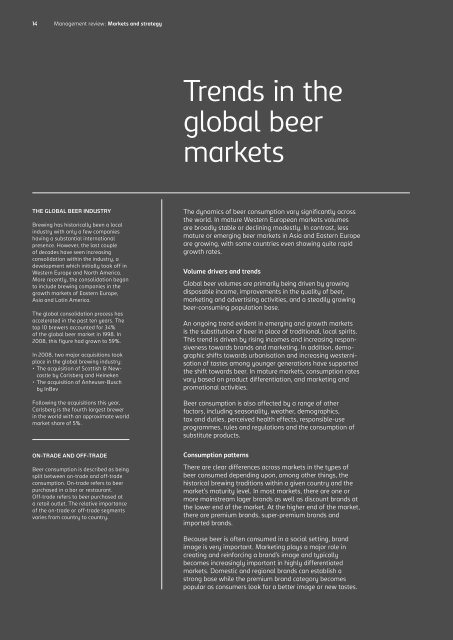
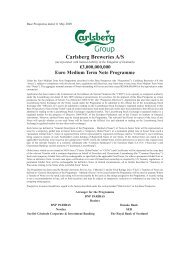
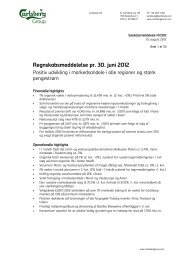

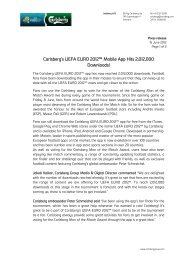
![[Name and Address] - Carlsberg Group](https://img.yumpu.com/49766377/1/184x260/name-and-address-carlsberg-group.jpg?quality=85)

![[Name and Address] - Carlsberg Group](https://img.yumpu.com/49015962/1/184x260/name-and-address-carlsberg-group.jpg?quality=85)
